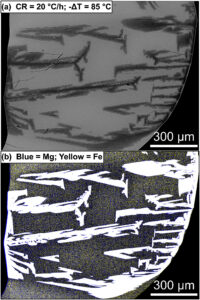Lang, S. ; Mollo, S. ; France, L. ; Misiti, V. ; Nazzari, M. (2021) Chemical Geology, 584, 120485
Voir en ligne : https://doi.org/10.1016/j.chemgeo.2021.120485

Abstract :
In order to elucidate the kinetic partitioning of cations between olivine and basalt, we performed undercooling (−ΔT) and cooling rate (CR) experiments at atmospheric pressure and QFM-2 buffer. Starting from the superliquidus temperature of 1250 °C, a Hawaiian tholeiitic basalt was cooled at the rates of 4 (CR4), 20 (CR20), and 60 (CR60) °C/h to the final target temperatures of 1175 °C (−ΔT = 35 °C ; −ΔT35) and 1125 °C (−ΔT = 85 °C ; −ΔT85). Results show that polyhedral olivine morphologies are obtained at -ΔT35, whereas strong disequilibrium skeletal and/or dendritic textures form at -ΔT85. The amount of forsterite in olivine decreases from to 85% to 78% with increasing both -ΔT and CR. A diffusive boundary layer also develops in the melt next to the olivine surface and its composition becomes progressively enriched in Ca, owing to its incompatible behavior with the lattice site. Residual melts are progressively depleted in silica and enriched in alkali from CR4 to CR60, but silica-rich melts are observed with increasing -ΔT. In terms of Fe2+-Mg exchange, olivines obtained at -ΔT35 are always in equilibrium with the diffusive boundary layer, comprising both the interface melt next to the olivine surface and the far-field melt where all chemical gradients cease. At -ΔT85, however, the Fe2+-Mg exchange indicates two distinct equilibration stages between olivine core and far-field melt, and between olivine rim and interface melt. Partition coefficients (Kd) of Mg, Fe, Mn, Ca, and Cr calculated at the olivine-melt interface preferentially change as a function of -ΔT rather than CR. From -ΔT35 to -ΔT85, KdMg, KdFe, KdMn, and KdCr remarkably increase, whereas the opposite applies to KdCa. Through the application of equilibrium partitioning models, we found that Mg, Fe, Mn, and Ca are incorporated into the olivine lattice site at near-equilibrium proportions. This generally good agreement with modeling data demonstrates that diffusive mass transport of cations in our experiments occurred under the conditions of local equilibrium at the olivine surface. In contrast, marked deviations from the expected equilibrium are found for KCr in response to the major influence of crystal field stabilization energy on cation incorporation.



